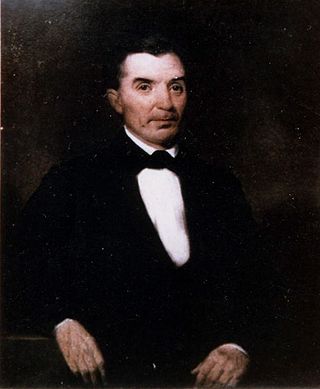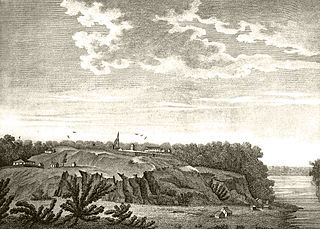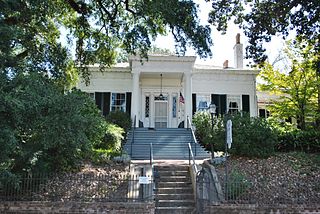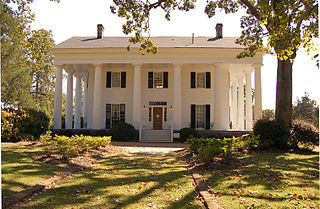Related Research Articles

Concordia Parish borders the Mississippi River in eastern central Louisiana. As of the 2020 census, the population was 18,687. The parish seat is Vidalia. The parish was formed in 1807.

Natchez is the only city in and the county seat of Adams County, Mississippi, United States. The population was 14,520 at the 2020 census. Located on the Mississippi River across from Vidalia in Concordia Parish, Louisiana, Natchez was a prominent city in the antebellum years, a center of cotton planters and Mississippi River trade.
The Natchez District was one of two areas established in the Kingdom of Great Britain's West Florida colony during the 1770s – the other being the Tombigbee District. The first Anglo settlers in the district came primarily from other parts of British America. The district was recognized to be the area east of the Mississippi River from Bayou Sara in the south and Bayou Pierre in the north.

The Natchez are a Native American people who originally lived in the Natchez Bluffs area in the Lower Mississippi Valley, near the present-day city of Natchez, Mississippi, in the United States. They spoke a language with no known close relatives, although it may be very distantly related to the Muskogean languages of the Creek Confederacy. An early American geographer noted in his 1797 gazetteer that they were also known as the "Sun Set Indians".

Isaac Franklin was an American slave trader and plantation owner. He was the co-founder of Franklin & Armfield, which became the largest slave trading firm in the United States. Based in Alexandria, Virginia, it also had offices in Natchez, Mississippi; New Orleans and other Louisiana cities. Franklin owned a total of six plantations in Tennessee and Louisiana. His Fairvue plantation, in Gallatin, Sumner County, Tennessee, was formerly listed on the National Register of Historic Places.

Étienne Perier or Étienne de Perier, also known as Perier the Elder, was a French naval officer and governor of French Louisiana from 1726 to 1733. His time as governor included some notable achievements, including the construction of the first levee along the Mississippi River in 1727. In response to the Natchez Revolt, he attempted to completely destroy the Natchez people, which increased Native American hostility toward the French in the territory. Because he failed to secure the safety of the colony, Perier was recalled as governor in March 1733. He later distinguished himself as a naval officer and privateer, including during the capture of HMS Northumberland in 1744.

Fort Rosalie was built by the French in 1716 within the territory of the Natchez Native Americans and it was part of the French colonial empire in the present-day city of Natchez, Mississippi.

"Green Leaves", also known as the Koontz House or the Beltzhoover House, is a Greek Revival mansion in Natchez, Mississippi, completed in 1838 by Edward P. Fourniquet, a French lawyer who built other structures in the area. It was purchased by George Washington Koontz, a local banker in 1849 and has been owned by his descendants ever since. It was listed on the National Register of Historic Places (NRHP) in 1979.

Antebellum architecture is the neoclassical architectural style characteristic of the 19th-century Southern United States, especially the Deep South, from after the birth of the United States with the American Revolution, to the start of the American Civil War. Antebellum architecture is especially characterized by Georgian, Neo-classical, and Greek Revival style homes and mansions. These plantation houses were built in the southern American states during roughly the thirty years before the American Civil War; approximately between the 1830s to 1860s.

Stephen Duncan was an American planter and banker in Mississippi during the 19th century. He was born and studied medicine in Pennsylvania, but moved to Natchez District, Mississippi Territory in 1808 and became the wealthiest cotton planter and the second-largest slave owner in the United States with over 2,200 slaves. He owned 15 cotton and sugar plantations, served as President of the Bank of Mississippi, and held major investments in railroads and lumber.

Edward McGehee was an American judge and major planter in Wilkinson County, Mississippi. He owned nearly 1,000 slaves to work his thousands of acres of cotton land at his Bowling Green Plantation.

Linden is a historic mansion in Natchez, Mississippi.

Lansdowne is a historic mansion that is listed on the National Register of Historic Places in Natchez, Adams County, Mississippi. It was originally built as the owner's residence on the 727-acre, antebellum, Lansdowne Plantation. The mansion and 120 acres are still owned and occupied by the descendants of the builder, who open it periodically for tours.
Stephen Minor (1760–1815) was an American plantation owner and banker in the antebellum South.

Captain William J. Minor was an American planter, slave owner, and banker in the antebellum South. Educated in Philadelphia, he lived at the Concord plantation in Natchez, Mississippi, and served as the second President of the Agricultural Bank. He was the owner of three large sugar plantations in Louisiana and supported the Union during the Civil War for the stability of the sugar trade.
Carlos Louis Boucher De Grand Pré was Spanish governor of the Baton Rouge district (1799–1808) and of Spanish West Florida (1805), as well as brevet colonel in the Spanish Army. He also served as lieutenant governor of Red River District and of the Natchez District.
Levin R. Marshall was an American banker and planter in the Antebellum South. He was a founder and President of the Commercial Bank of Natchez, Mississippi. He owned 14,000 acres in Mississippi and Louisiana, and 10,000 acres in Arkansas.

The Cypress Grove Plantation was a Southern plantation owned by President Zachary Taylor near Rodney, Mississippi. Later, it was also known as Buena Vista Plantation.
The Canemount Plantation is a historic Southern plantation in Lorman, Mississippi.

Homewood Plantation was a historic plantation with a mansion of the same name located on it in Natchez, Adams County, Mississippi. Built in 1860 as a wedding present for the Southern belle Catherine Hunt, the daughter of millionaire planter David Hunt, the mansion remained unscathed during the American Civil War of 1861-1865. By the early twentieth century, it was used as a shooting location for 1915 classic film The Birth of a Nation. The author Stark Young used Homewood as the setting of a wedding in his 1934 novel So Red the Rose. The mansion burnt down in 1940.
References
- 1 2 3 4 5 6 7 8 9 10 "The Burning of "Concord": Old Mansion at Natchez, Miss., Was Owned by a New Yorker". The New York Times. March 24, 1901. p. 1. Retrieved March 30, 2015– via Newspapers.com.
- ↑ Elmal Vaney, Lost Mississippi: Concord, Natchez (1789-1901), Preservation in Mississippi, May 4, 2010
- ↑ Raymond J. Martinez, Rousseau: The Last Days of Spanish New Orleans, Gretna, Louisiana: Pelican Publishing, 2003, p. 93
- ↑ Mary Carol Miller, Lost Mansions of Mississippi, Oxford, Mississippi: University Press of Mississippi, 1996, pp. 3-5
- ↑ Clare D'Artois Leeper, Louisiana Place Names: Popular, Unusual, and Forgotten Stories of Towns, Cities, Plantations, Bayous, and Even Some Cemeteries, Baton Rouge, Louisiana: Louisiana State University Press, 2012, p. 71
- ↑ Concord Archived May 3, 2015, at the Wayback Machine , Mississippi Department of Archives and History
31°33′53″N91°22′53″W / 31.564753°N 91.381466°W